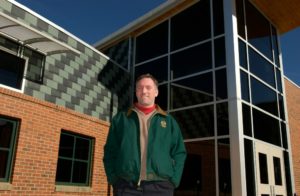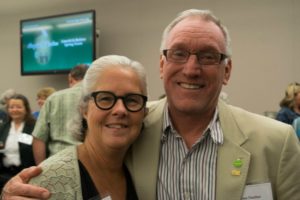Story by Christian Knoll
Legacies, much like the ancient city of Rome, are not built in one day. The status of greatness is earned through will, passion and countless acts of selfless contributions toward something bigger than his or her self. This is Director of the Colorado State University Institute for the Built Environment and Professor Brian Dunbar’s story. Dunbar was recently honored through the College of Health and Human Sciences Legacies Project. The Legacies Project pays tribute to former faculty and staff by gathering, archiving and sharing personal and professional histories.
Early influences

Dunbar always had an eye for creation. His family, namely his father and grandfather, were architects. And his mother instilled interior design concepts. From her, he learned a sense of space, place and of course, taste. As a child, Dunbar visited many construction sites with his father. By the 10th grade, Dunbar started working in his father’s office. It was there where he learned about the production of architecture.
After experiencing the excitement of seeing design ideas become buildings, he approached his father and told him that one day he would like to be an architect. His father replied, “I’ll tell you the same thing my dad told me. You’re not coming to work for me.”
Understanding his father’s intentions and inspired by his father’s practice, Dunbar attended the University of Michigan’s Architecture School. After six years, Dunbar walked out with a master’s degree in hand, and the rest of his life ahead of him. With his father’s words in mind, and the intention of building his own career, Dunbar headed west to the Centennial State, Colorado.
Fort Collins and CSU

Alongside his new wife, Karen, Dunbar arrived in Fort Collins in 1981. For a time, he worked for Architecture Plus. While working one day, the opportunity of a lifetime came along. His boss, Jim Cox, walked in and said, “I’m supposed to be at CSU critiquing student design projects, but I have a conflict. Can anyone step in for me?”
Dunbar volunteered to fill the role, and what soon followed was the start of a long, prosperous and impactful career at the University. He learned that he loved teaching; he also valued learning, which is something his family instilled into him at a young age.
“There is a secret of teaching that I learned fairly early at Colorado State,” Dunbar said. “And that is, teachers who are open to it get to learn a lot from their interactions with students.”
In 1983, at the age of 25, CSU hired Dunbar as a tenure-track assistant professor in the art department teaching in the Interiors program; his career at the University changed with consolidation of programs. In 1989, the interior design program transitioned to the Department of Design and Merchandising.
Institute for the Built Environment
Five years later, Dunbar worked with Nancy Hartley, dean of the College of Applied Human Sciences (now the College of Health and Human Sciences), who proposed an idea of interdisciplinary collaboration to Dunbar. Dunbar’s idea and Hartley’s support led to the creation of the Institute for the Built Environment (IBE) in 1994, which he continues to direct to this day.
Dunbar’s interest in the environment and sustainability began in high school during the 1970s through the influence of his composition teacher.
“Coming from a small town where few went onto college, Dr. Mary Roberti had a profound impact on me when she challenged me to research the intersection of architecture and energy after the U.S. energy crisis,” Dunbar said.
Transition to construction management
Intrigued by the impact of sustainable building practices on the built environment, Dunbar transitioned from interior design to the Department of Construction Management in 1999 where Larry Grosse, the former CM department head, asked him to teach courses on sustainability and green building and champion the work of IBE.
The Institute seeks to utilize faculty from a variety of disciplines and schools of thought to “advance the development of healthy, thriving built environments,” working with experts on and off campus to help improve not only CSU, but local, national and international communities.
The IBE serves as a guide for the creation of heathy and sustainable buildings, schools and neighborhoods. IBE also works with CSU faculty and students to apply for grants to carry out various research projects.
Full-time director of IBE

In 2012, Dunbar “retired” from his role as a professor to direct IBE full time. He continues to teach and mentor students through IBE and also to provide outreach off-campus to community partners. To this day, Dunbar has taught and mentored more than 100 CSU students. IBE remains a part of CSU’s College of Health and Human Sciences.
“Brian has had different careers over his time at the University… [The Institute] has this team of experts that can lead after he is gone, and can help further what we are trying to do climate-wise in the United States,” said Bruce Hendee, a member of both the American Society of Landscape Architects and Leaders at the Core of Better Communities.
On campus, IBE has supported many projects seeking LEED certification such as the Lory Student Center remodel. The LSC serves as a student and faculty hub that many utilize on a daily basis. Off campus and across the Colorado-Wyoming border, the Institute assisted in the creation of the Cheyenne Botanic Gardens, which “inspires, beautifies and enriches the greater High Plains community through gardening, volunteerism, education and stewardship.”
A lasting legacy
Now, after nearly 22 years, IBE continues to promote the concepts of environmental and social sustainability, green architecture and community building. Dunbar continues to remain affiliated with the University through IBE despite his “semi-retirement.”
To watch a video about Dunbar and to make a gift in his honor, go to his Legacies webpage. You can make a gift to one of two funds: the Institute for the Built Environment fund and the Brian Dunbar Future Leaders for Built Environments fund.
Through his selfless and forward-thinking contributions, Dunbar has succeeded in lessening our environmental footprint, improving our health and strengthening our communities, and with that, Dunbar leaves his mark – an inspirational legacy for us all to follow.
The Institute for the Built Environment is part of CSU’s College of Health and Human Sciences.